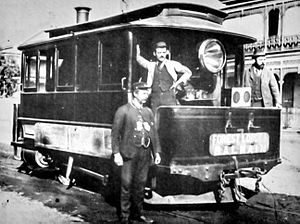
A tram is a type of urban rail transit consisting of a rail vehicle, either individual railcars or self-propelled trains coupled by a multiple unit, that runs on tramway tracks on urban public streets; some include segments on segregated right-of-way. The tramlines or networks operated as public transport are called tramways or simply trams/streetcars. Many recently built tramways use the contemporary term light rail.

The Powerhouse Museum is the major branch of the Museum of Applied Arts & Sciences (MAAS) in Sydney, and owned by the Government of New South Wales. The Powerhouse is a collection of museums with its main centre in Ultimo, New South Wales, the others being the historic Sydney Observatory at Observatory Hill, and the newer Museums Discovery Centre at Castle Hill.
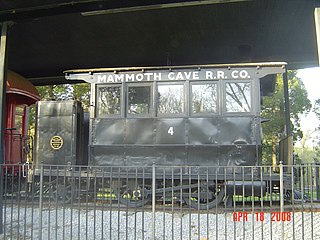
A steam dummy or dummy engine, in the United States and Canada, was a steam locomotive enclosed in a wooden box structure made to resemble a passenger railroad car. Steam dummies had some popularity in the first decades of railroading in the U.S., from the 1830s but passed from favor after the American Civil War.
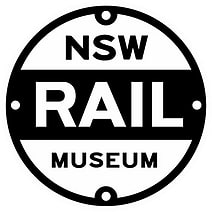
The NSW Rail Museum is the main railway museum in New South Wales, Australia. A division of Transport Heritage NSW, it was previously known as the New South Wales Rail Transport Museum (NSWRTM), Rail Heritage Centre and Trainworks.

The Sydney tramway network served the inner suburbs of Sydney, Australia, from 1879 until 1961. In its heyday, it was the largest in Australia, the second largest in the Commonwealth of Nations, and one of the largest in the world. The network was heavily worked, with about 1,600 cars in service at any one time at its peak during the 1930s . Patronage peaked in 1945 at 405 million passenger journeys. Its maximum street trackage totalled 291 km in 1923.
This list collects the transport-related vehicles exhibited or owned by the Museum of Transport and Technology (MOTAT) in Auckland, New Zealand.

A tram engine is a steam locomotive specially built, or modified, to run on a street, or roadside, tramway track.

Merryweather & Sons of Clapham, later Greenwich, London, were builders of steam fire engines and steam tram engines.
The history of trams, streetcars, or trolleys began in the early nineteenth century. It can be divided up into several discrete periods defined by the principal means of motive power used.

The Newcastle Tram System was an extensive network that operated between Newcastle and the outer suburb of Wallsend from 1887 to 1950. At its peak the line extended from the city to Speers Point and West Wallsend. The service was rarely profitable, and low utilisation for a variety of reasons including the convenience of buses led to it closing and the tracks being removed.
The West Wallsend Steam Tram Line in Australia was an extension of the tram line from Newcastle, New South Wales to Wallsend, New South Wales. Construction of the tram line began in April 1909 and opened for passenger services on 19 December 1910. The route from Newcastle to West Wallsend was 25 km (16 mi) long and took about one and a half hours. The line was standard gauge and the tram was powered by a steam motor which hauled two passenger cars or carriages.

The earliest trams in Australia operated in the latter decades of the 19th century, hauled by horses or "steam tram motors". At the turn of the 20th century, propulsion almost universally turned to electrification, although cable trams lingered in Melbourne. In cities and towns that had trams, they were a major part of public transport assets.

The New South Wales Z12 class was a class of 4-4-0 steam locomotives operated by the New South Wales Government Railways of Australia.
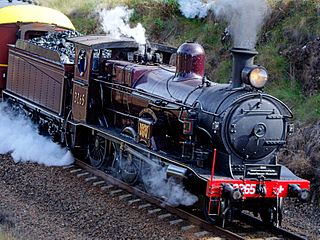
3265 is a preserved former New South Wales Government Railways C32 class steam locomotive. Built in 1902 by Beyer, Peacock & Company, England, it is owned by the Powerhouse Museum and based at the NSW Rail Museum, Thirlmere.

The Sydney trolleybus system in New South Wales consisted of two unconnected lines in the Eastern Suburbs and St George areas of Sydney.
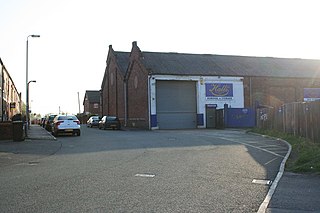
Wigan Corporation Tramways operated a tramway service in Wigan, England, between 1901 and 1931. The first tramway service in the town was run by the Wigan Tramways Company, whose horse trams began carrying passengers in 1880. They began replacing horses with steam tram locomotives from 1882, but the company failed in 1890 when a Receiver was appointed to manage it. The Wigan & District Tramways Company took over the system in 1893 and ran it until 1902. Meanwhile, Wigan Corporation were planning their own tramway system, obtaining an authorising Act of Parliament in 1893, and a second one in 1898. This enabled them to build electric tramways, and in 1902, they took over the lines of the Wigan & District Tramways Company.
At the peak of Britain’s first-generation tramways, it was possible to travel by tram all the way from Pier Head at Liverpool to the Pennines in Rochdale by tram.

The P-class trams were a class of trams operated on the Sydney tram network.

The C-class trams were a class of single bogie end-loading electric trams operated on the Sydney tram network.

Rockhampton Council Tramways was a steam tram service which was operated by Rockhampton City Council from 1909 until 1939 in the city of Rockhampton, Queensland, Australia. Rockhampton was the only regional city in the state of Queensland to have had a tram service. The line has since been rebuilt and is operated as a tourist attraction by the Archer Park Rail Museum.

Valley Heights Steam Tram Rolling Stock is a heritage-listed collection of tramway machinery at 17b Tusculum Road, Valley Heights, City of Blue Mountains, New South Wales, Australia. It was built from 1889 to 1891. The property is owned by Steam Tram and Railway Preservation (Co-op) Society. It was added to the New South Wales State Heritage Register on 21 October 2016.
